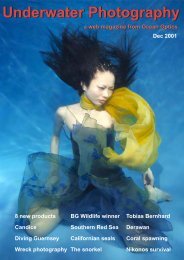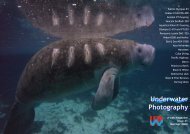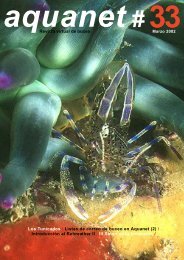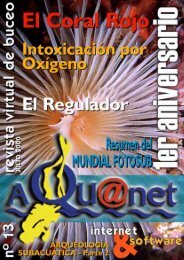Underwater Photography - SENSACIONES.org
Underwater Photography - SENSACIONES.org
Underwater Photography - SENSACIONES.org
Create successful ePaper yourself
Turn your PDF publications into a flip-book with our unique Google optimized e-Paper software.
A giant octopus swims gracefully above the IMAX® 3D camera in the cold waters<br />
pf British Columbia. Photo copyright© 2005 Warner Bros Entertainment Inc.<br />
Photo Peter Kragh<br />
and nudibranch and anemone, the<br />
symbiotic arrangement between<br />
the Green Sea Turtles and various<br />
Surgeonfish is one of mutual benefit.<br />
Howard Hall offers, “These<br />
turtles come from long distances<br />
to this one spot in Kona, Hawaii,<br />
where reef fish will clean the algae<br />
off of their shells. If they didn’t do<br />
that and if the fish weren’t willing,<br />
algae would continue to grow and<br />
eventually the turtles would have<br />
a hard time swimming. They need<br />
this cooperative behavior in order<br />
to be healthy. And these fish benefit<br />
www.uwpmag.com<br />
because they get something to eat.<br />
There are lots of kinds of symbiotic<br />
relationships like that in the ocean,<br />
and it was our aim to show just how<br />
vital these relationships are. And it’s<br />
an absolutely beautiful sequence.”<br />
Before departing the Hawaiian<br />
waters, cameras were also focused on<br />
the elegant and enormous Manta Ray,<br />
the harmless and gentle giant captured<br />
in a nighttime forage for food.<br />
At the beginning of the summer<br />
of 2005, a change in location<br />
occurred, when production set down<br />
in North Carolina, along the 70-<br />
mile Outer Banks of Cape Hatteras<br />
National Seashore. Offshore, 120 feet<br />
down, lies the remains of the Papoose,<br />
a ship sunk by a German U-Boat<br />
during the Second World War, which<br />
serves as the manmade and animaladopted<br />
habitat of the Sand Tiger<br />
Sharks.<br />
Filming in the deepest waters<br />
yet, Hall and company tackled the<br />
new challenges with their customary<br />
can-do attitude: “Certainly filming on<br />
the shipwrecks off North Carolina was<br />
really interesting work, because we<br />
were doing really deep dives and we<br />
were staying down for long periods<br />
of time. Our longest dive was in<br />
North Carolina; we were underwater<br />
for four-and-a-half hours. We spent<br />
two hours underwater at 120 feet, and<br />
then we had to spend two-and-a-half<br />
hours of decompression at the end of<br />
the dive. And we did that dive on four<br />
consecutive days.”<br />
The crew immediately hopped<br />
south to the Bahamas, where<br />
production set down for close to<br />
a month and shot a wide range of<br />
sequences involving diverse groups of<br />
animals: Lemon Sharks, Caribbean<br />
Reef Sharks, grouper, coral reef and a<br />
litany of fish and other creatures who<br />
call the reef home. The filmmakers<br />
were also confronted by Tiger Sharks<br />
(not to be confused with the Sand<br />
Tigers), which do have an aggressive<br />
nature and have been known to eat<br />
humans. Again, Hall did not employ<br />
shark cages, but instead, relied upon<br />
his years of experience to maintain<br />
safety during filming in the warm<br />
Caribbean waters.<br />
The month of August brought<br />
a deadline situation, as the crew was<br />
committed to filming the annual coral<br />
spawning at the Flower Garden Banks<br />
National Marine Sanctuary in the Gulf<br />
of Mexico—which scientists have<br />
been able to pinpoint as occurring on<br />
the eighth night after the August full<br />
moon.<br />
Filming such a once-in-a-year<br />
event, Hall and his crew took every<br />
precaution, going through a litany<br />
of “what ifs?” and coming up with<br />
failsafe measures to ensure that the<br />
coral spawning would be filmed. All<br />
equipment was put through quadruple<br />
checks and systems were a go just<br />
prior to the appointed spawning hour.<br />
With everyone and all the equipment<br />
ready to begin filming the sequence,<br />
and within moments of the spawning<br />
starting, the lights literally went out.<br />
Michele Hall explains, “I was on<br />
the boat coordinating the deck-side<br />
activities, when Howard frantically<br />
notified me via his underwater<br />
communication system that the lights<br />
had suddenly gone out! At first, we<br />
thought it might be a blown fuse,<br />
but we quickly determined that there<br />
was a problem with one of the light<br />
cables.”<br />
29/21

















